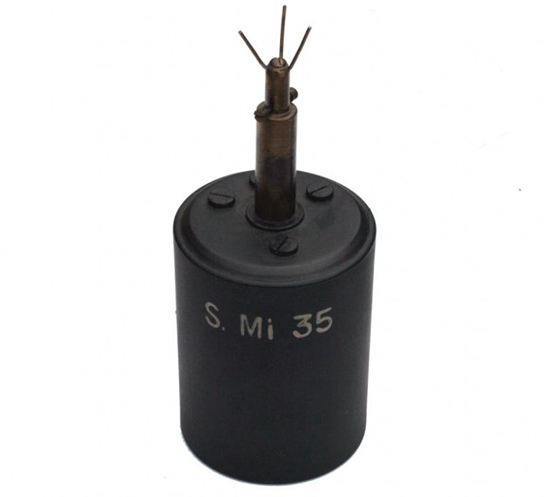Schrapnellmine 35 bounding mine – S-Mine
History, technical sheet and photo

Schrapnellmine 35 bounding mine history
It was in the 1930s that German engineers developed a new leaping anti-personnel mine. Triggered by the traction of a trap wire connected to one of the three metal axes protruding from the ground (the rest of the mine being buried), the mine projects the explosive charge about one meter from the ground, air
The production of the “Schrapnellmine 35” began in 1935. When World War II broke out, thousands of these “S-Minen 35” were buried to forbid access to the Saar. Subsequently, most of the sensitive sites in the countries occupied by Nazi Germany are equipped. This is particularly true of the Atlantic Wall, which receives hundreds of thousands of models for the protection of German bases, especially in Normandy. 15,000 S-Minen are neutralized by the Americans in the area of Utah Beach in Pouppeville after disembarkation.
The Allies nicknamed it the “Bouncing Betty”. Widely used in North Africa, it also equipped some German vehicles for their anti-personnel defense. A new version was produced in 1944 (Schrapnellmine 44) but did not offer a revolutionary improvement over the model 35.
Many armies around the world are inspired by the Schrapnellmine process: France with its 1939 model mine, the United States and its M2 (little used) and M16 mines, the Soviet Union and itsOZM-4. The same with Finland, China, Sweden and Italy. Nowadays, a lot of leaping mine models are still in use.
Schrapnellmine 35 bounding mine history
Creator/User: Germany
Denomination: Schrapnellmine 35
Number produced (1935-1945): 1,930,000
Type of mine: bounding anti-personnel mine
Explosive: 182 grams of TNT
Total weight: 4,1 kg
Height: 12,7 cm
Diameter: 10,2 cm


